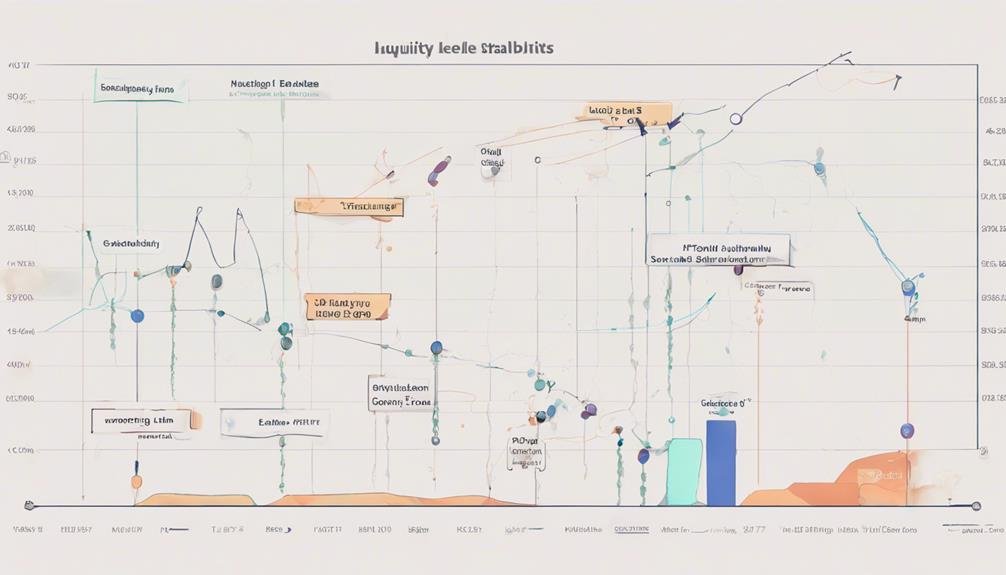Maintaining price stability in stablecoins hinges on diverse strategies: effective reserve management, algorithmic controls, collateral pool diversification, regulatory compliance, and liquidity management. Diversifying reserves minimizes risks, while real-time monitoring allows timely adjustments for stability. Algorithmic controls react swiftly to market changes, aiding stability. Collateral pool diversification mitigates risk exposure, ensuring stablecoin value. Compliance practices and transparency uphold regulatory standards, building trust. Vital for stablecoin availability and value stability. These strategies form a robust framework for stablecoin price stability. More insights await for a deeper understanding of stablecoin stability maintenance.
Table of Contents
Brief Overview of How Do Stablecoins Maintain Price Stability
- Diversify reserves across assets for risk mitigation and liquidity.
- Implement algorithmic controls for real-time supply adjustments.
- Maintain a well-diversified collateral pool to stabilize value.
- Prioritize regulatory compliance to build trust and avoid consequences.
- Monitor and manage liquidity effectively for stability and availability.
Reserve Management Strategies
Effective reserve management in stablecoins plays a pivotal role in maintaining price stability by balancing the supply and demand of the stablecoin. Reserve management strategies often involve diversifying reserves across various assets to mitigate risks and guarantee liquidity in the system. By regularly monitoring reserves and market conditions, issuers can make timely adjustments to uphold the stablecoin peg. Additionally, incorporating mechanisms for automatic supply adjustments based on real-time data and market trends can further enhance the stability of the stablecoin.
Transparency in reserve management practices is essential as it builds trust among stablecoin users and strengthens the overall ecosystem. Users are more likely to have confidence in a stablecoin where reserve management practices are transparent and easily understood. By ensuring clear communication and visibility into how reserves are managed, issuers can foster a sense of security and reliability in the stablecoin. Overall, effective reserve management strategies are pivotal for maintaining price stability and ensuring the long-term viability of stablecoins in the market.
Algorithmic Controls Implementation

Implementing algorithmic controls in stablecoins involves the utilization of pre-defined algorithms to adjust token supply based on price movements, ensuring stability without the need for traditional asset backing. These controls play a vital role in managing volatility in the market and maintaining the stability of the stablecoin. To effectively implement algorithmic controls in stablecoins, the following steps are essential:
- Continuous Monitoring: Constantly monitoring price movements and market conditions allows the algorithm to react promptly and make necessary adjustments to the token supply to uphold stability.
- Algorithm Flexibility: Building flexibility into the algorithm enables it to adapt to various market scenarios and adjust the token supply accordingly, ensuring resilience against sudden fluctuations.
- Risk Assessment: Conducting regular risk assessments helps in identifying potential threats to stability and allows for preemptive measures to be taken to mitigate risks and manage volatility effectively.
Collateral Pool Diversification

Diversifying the collateral pool within stablecoins is a key strategy for reducing risk exposure and enhancing stability across various asset classes. By spreading exposure across different types of assets like fiat currencies, cryptocurrencies, and commodities, the risk of significant losses due to a single asset’s price fluctuations is mitigated. This approach not only helps in stabilizing the stablecoin value but also enhances resilience against market shocks.
Regularly evaluating and adjusting the asset composition of the collateral pool based on prevailing market conditions is essential for maintaining stability. A well-diversified collateral pool can also guarantee liquidity, enabling the stablecoin to meet redemption demands efficiently. This diversification strategy acts as a risk mitigation tool, safeguarding the stablecoin against extreme price fluctuations in any particular asset class. Overall, a balanced and diversified collateral pool enhances the stablecoin’s ability to withstand varying market conditions and reinforces its stability in the face of unexpected challenges.
Regulatory Compliance Practices

Regulatory compliance practices form the cornerstone of ensuring stablecoins operate within legal boundaries and adhere to established standards and guidelines. To effectively navigate the complex regulatory landscape, stablecoin issuers must implement robust compliance measures. Here are three key practices they should focus on:
- Thorough Documentation: Maintaining detailed records of transactions, policies, and procedures is essential to demonstrate adherence to regulatory requirements. Clear documentation helps in audits and regulatory inquiries, ensuring transparency in operations.
- Compliance Reporting: Regular reporting to regulatory authorities showcases a commitment to compliance. The timely submission of reports on AML and KYC measures adopted by the stablecoin issuer is critical to maintaining regulatory trust.
- Transparency and Accountability: Emphasizing transparency in operations and decision-making processes fosters trust among stakeholders. Accountability for regulatory compliance measures is paramount to avoid consequences such as fines, legal actions, and reputational damage that non-compliance can bring.
Liquidity Monitoring and Management

Effective management of liquidity plays an essential role in maintaining stability and ensuring sufficient availability of stablecoins in the market. Liquidity monitoring involves tracking the availability of stablecoins to guarantee an adequate supply for trading, which is important for stabilizing stablecoin prices by matching supply with demand. Monitoring trading volume and order book depth is significant in understanding market liquidity dynamics and making informed decisions.
Utilizing liquidity pools and engaging in market-making activities can further enhance price stability in stablecoins by providing additional liquidity to the market. Regular audits and transparency in liquidity reserves are also important for maintaining trust and stability in stablecoin markets. By implementing robust liquidity management strategies and closely monitoring liquidity metrics, issuers can better navigate market fluctuations and uphold the stability of their stablecoin offerings.
Frequently Asked Questions
How Do Stablecoins Stabilize Their Prices?
Stablecoins employ a combination of market dynamics, supply management, demand response, and algorithmic strategies to stabilize prices. External factors, reserve assets, economic indicators, peg mechanisms, arbitrage opportunities, and liquidity pools are key components ensuring stability.
How Can Stablecoins Seek to Achieve Stability?
To achieve stability, stablecoins utilize market dynamics, algorithmic mechanisms, reserve management, economic incentives, collateral backing, governance structure, risk management, liquidity provision, accurate price feeds, and response to market demand. These elements collectively support the stable value proposition.
How Do I Make My Stablecoin Stable?
To make a stablecoin stable:
- Employ market strategies, algorithmic mechanisms, and economic models for risk management.
- Utilize liquidity pools, collateral assets, and governance structures.
- Manage reserves, price feeds, and market dynamics effectively to guarantee stability.
Which Cryptocurrency Is Used to Support the Price Stability of Stablecoins?
Stablecoins like Tether (USDT) use a reserve of cryptocurrencies like Bitcoin and Ethereum for price stability. Ethereum collateral, Bitcoin backing, and USD support are common in stablecoin design, ensuring peg consistency and trustworthiness.
Conclusion
To sum up, maintaining price stability in stablecoins requires a combination of reserve management, algorithmic controls, collateral pool diversification, regulatory compliance, and liquidity monitoring. These strategies work together to guarantee that stablecoins remain pegged to their underlying assets and provide a reliable store of value. By implementing these practices effectively, stablecoin issuers can build trust among users and uphold the stability of their digital assets in the ever-evolving cryptocurrency market.




